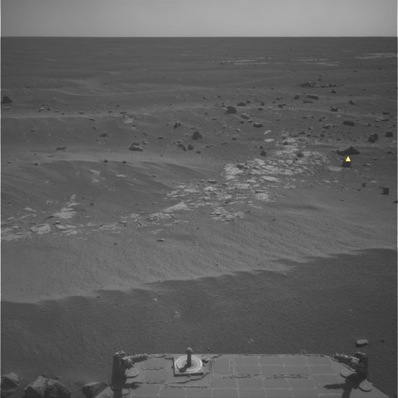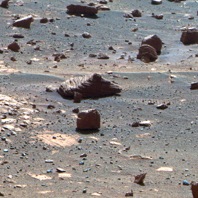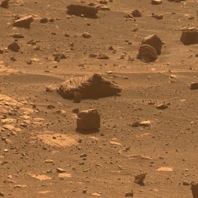
Opportunity chooses
own targets
DR EMILY BALDWIN
ASTRONOMY NOW
Posted: 24 March


NASA's Mars Exploration Rover Opportunity is now equipped with software that allows it to choose its own rocks for further examination, demonstrating the power that future autonomous robotic missions might be able to offer.
Armed with new software the rover examines images taken with its wide-angle navigation camera and selects rocks based on a predefined criteria, such as shape and colour. It can then centre its narrower angle camera on the chosen target and take multiple images using colour filters.

Opportunity took this image using the navigation camera during the 2,172nd Martian day of its mission, identifying the rock with the yellow marker as one that best matched the selection criteria defined by scientists back on Earth. Image: NASA/JPL-Caltech.
“It’s a way to get some bonus science,” enthuses rover driver Tara Estlin, who has lead the development of this new software system, called Autonomous Exploration for Gathering Increased Science (AEGIS).
The software speeds up proceedings on the Martian surface. Without it, follow-up observations depend on transmitting the navigation camera images back to Earth for scientists to peruse, before sending a command back to the rover to examine the chosen target the next day. This time-consuming process sometimes means that the rover may be driven again before potential targets have been identified.


First observation of the selected target, in false colour (left) and true colour (right). Image: NASA/JPL-Caltech/Cornell University
Opportunity's test run proved highly successful. The rover, which has just entered its seventh year of operations on the red planet, picked out a rock out of 50 possible candidates for further study, based on its instructions to focus on large and dark rocks. The rock is about the size of a football, displays a tan colour and is layered in texture, and appears to have been thrown out of a nearby crater.
“It found exactly the target we would want it to find,” says Estlin. “This checkout went just as we had planned, thanks to many people’s work, but it’s still amazing to see Opportunity performing a new autonomous activity after more than six years on Mars.”
The software can be used at various stopping points along a single day's drive, or at the end of a day's operations, enabling it to identify numerous targets that might otherwise be missed. “We spent years developing this capability on research rovers in the Mars Yard here at JPL,” adds Estlin. “Six years ago, we never expected that we would get a chance to use it on Opportunity.”
The software adds to other decision-making processes handed over to the rover, such as choosing routes around obstacles, and the ability to only send images of the sky that contain clouds or dust devils back to Earth. The latest upgrade sets the stage for the autonomous capabilities of future Mars rovers.
|



